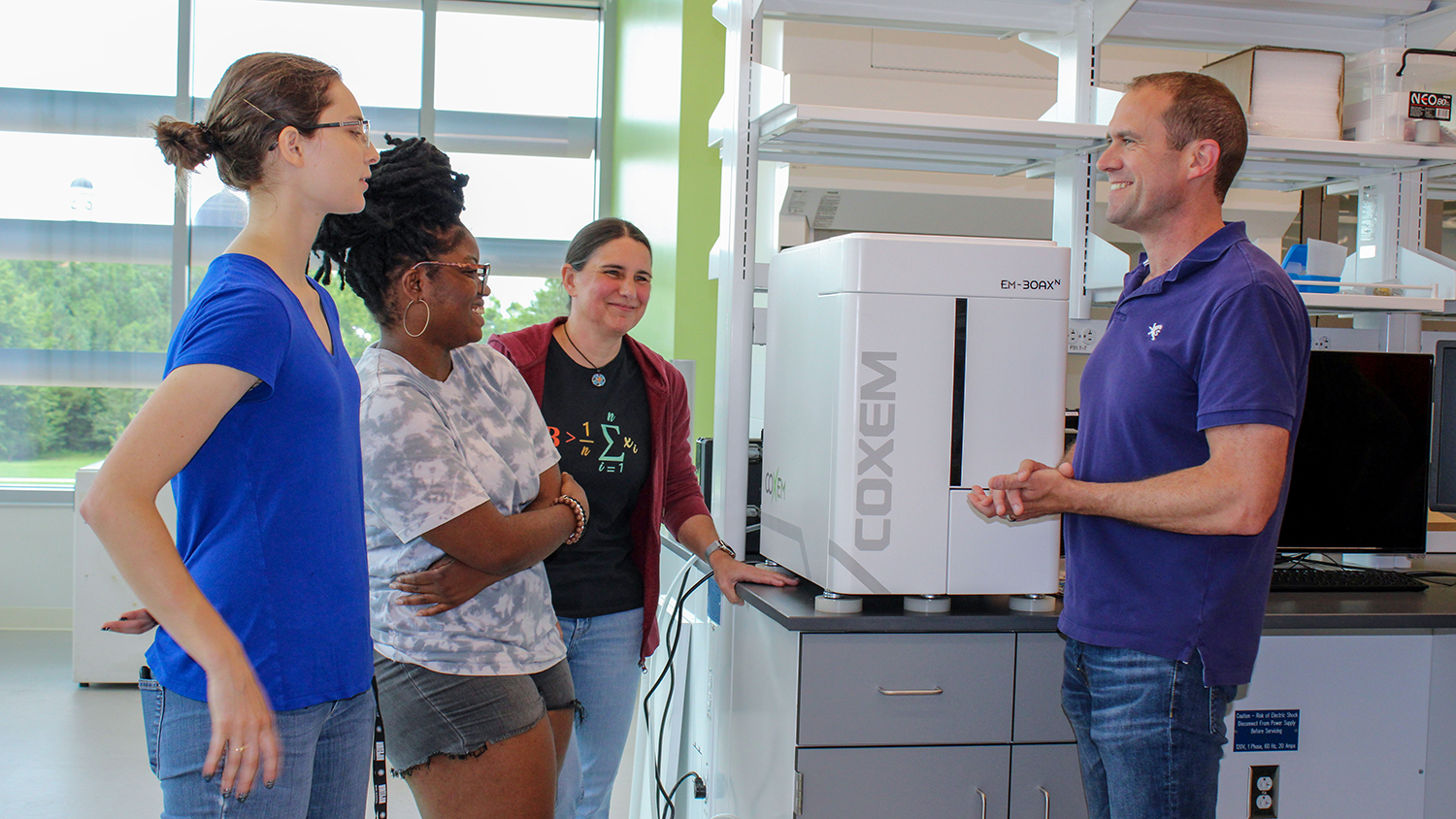STEPS Center takes on phosphorus sustainability

In the first year since the Science and Technologies for Phosphorus Sustainability (STEPS) Center launched, 20 research projects are in progress — all working toward the goal of reducing dependence on phosphorus mining and the amount of phosphates lost to water and soil.
A National Science Foundation (NSF) Science and Technology Center (STC), STEPS is funded by a $25 million, five-year cooperative agreement that is renewable for an additional five years. Researchers at NC State and other institutions in the physical, social, life and economic sciences are working across the center’s four themes: materials scale, human-technology scale, regional and global scale, and convergence science education and convergence informatics.
As of April, STEPS has a new headquarters in the recently opened Plant Sciences Building (PSB) on Centennial Campus. PSB provides space for social and networking activities, including presentations, as well as offices and labs.
“STEPS is a highly interdisciplinary center located in a building that is designed to integrate highly interdisciplinary research,” said Jacob Jones, Kobe Steel Distinguished Professor of Materials Science and Engineering and director of STEPS. “Our approach to solving problems through interdisciplinary work is synergistic and therefore being in the PSB is a great opportunity for STEPS.”
Building up research from the atomic scale
Elizabeth Trubchaninov, a Ph.D. student in the Department of Materials Science and Engineering (MSE) and president of the STEPS Student Leadership Council, is using different analytical systems, such as energy dispersive X-ray spectroscopy and X-ray photoelectron spectroscopy, to identify the presence of phosphorus in soil, water and wastewater samples to pinpoint at the atomic level where phosphorus is captured.
Comparing model samples from the lab and samples from the field, her contributions in method development will provide future researchers with a more complete understanding of the different characteristics of the element by standardizing techniques of how much information can be rendered from a particular sample.
“I hope my work can translate over to methods that allow for phosphorus recapture or recycling,” Trubchaninov said. “My work might take time, but if it’s not through my direct work, I hope someone else who steps up can look at my work and relate it to their project so that they can help the phosphorus problem.”
One important focus is capturing phosphorus that has run off into bodies of water where it can stimulate the growth of algal blooms that can lead to the formation of dead zones. Darrell
Harry, a Ph.D. student in MSE, is working on a project centered on phosphorus capture and recovery through the use of metal cation-containing materials.
Harry systematically immerses oxidized, powder forms of metal cation-containing materials like aluminum, iron(III) and lanthanum in phosphate solutions in different experimental conditions. Afterwards, he characterizes the liquid and solid materials using a spectrophotometer to measure how much phosphate is captured in these materials.
“We’re trying to understand how this process of capture can help inform us on the potential effects materials like these can have in the long term so that we can develop safe, sustainable and high-performing capture materials, and how we can use that to inform our future research decisions,” Harry said.
Harry will be expanding his research to study the release of phosphates from the metal cation-containing material while continuing to analyze their capture potential.
A global, inclusive approach
Phosphorus is an essential element. Decreasing dependence on it is not easy, as global food systems rely on phosphorus fertilizers. STEPS has ambitious numbers to meet: reducing human dependency on mined phosphates by 25 percent and reducing the loss of phosphorus to water and soil sources by 25 percent within 25 years.
“If we continue to use it unsustainably with the world’s growing population, we’re going to continue to degrade our environment,” Jones said. “It’s in humanity’s best interest to start controlling the problem and that involves engineering.”
While some researchers are coming up with new technologies to capture and reuse phosphorus from the environment or to develop next-generation fertilizers, others are identifying how these will be scaled up locally, regionally and globally while accounting for socioeconomic and environmental factors. STEPS is using a convergence research informatics approach to provide data-driven guidance as researchers navigate their approaches and experiments around phosphorus sustainability.
It takes a diverse team to tackle this challenge, and not just in terms of different disciplines. Since the center’s inception, Jones and his colleagues have made progress toward diversifying participation through strategic recruitment and the promotion of opportunities to individuals of traditionally underrepresented groups in engineering.
Within five years, the center’s goal is for 50 percent of participants to be members of underrepresented minority or racial groups, in both research projects and in pre-college programs. After one year, 25 percent of STEPS participants are from underrepresented groups, 50 percent are women and 7 percent self-identify with a disability.
As an NSF STC, the center has participating institutions around the U.S., which is critical for conducting research relevant to different ecosystems with different concerns. For example, in south Florida, researchers are looking at the flow of phosphorus through the region’s aquatic ecosystem while researchers in Arizona are studying the capture and recycling of phosphorus through urban systems.
NC State serves as the lead institution, and partners include Appalachian State University; Arizona State University; Clemson University; the Joint School of Nanoscience and Engineering between North Carolina Agricultural and Technical State University and the University of North Carolina at Greensboro; Marquette University; RTI International; the University of Florida; and University of Illinois at Urbana-Champaign.
This post was originally published in College of Engineering News.